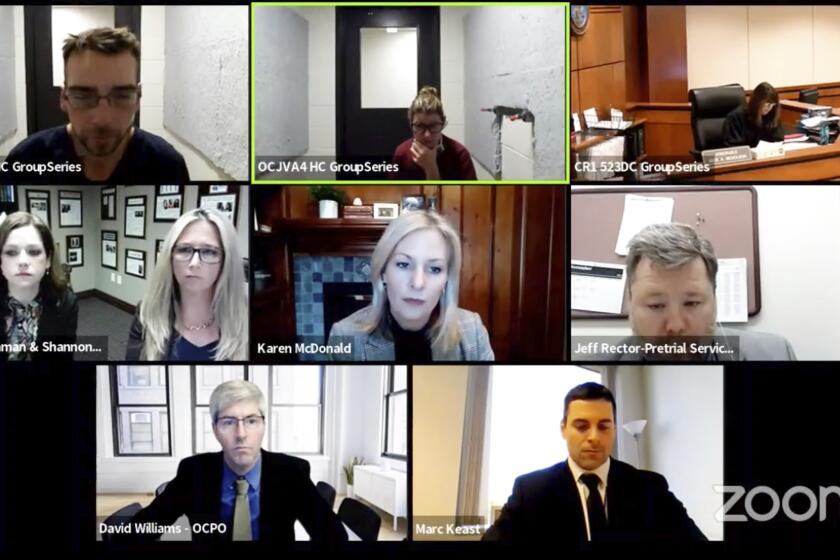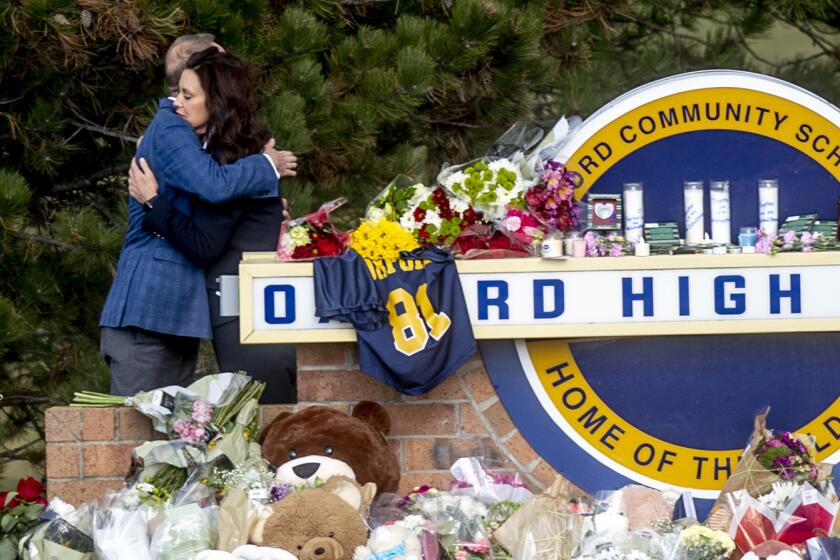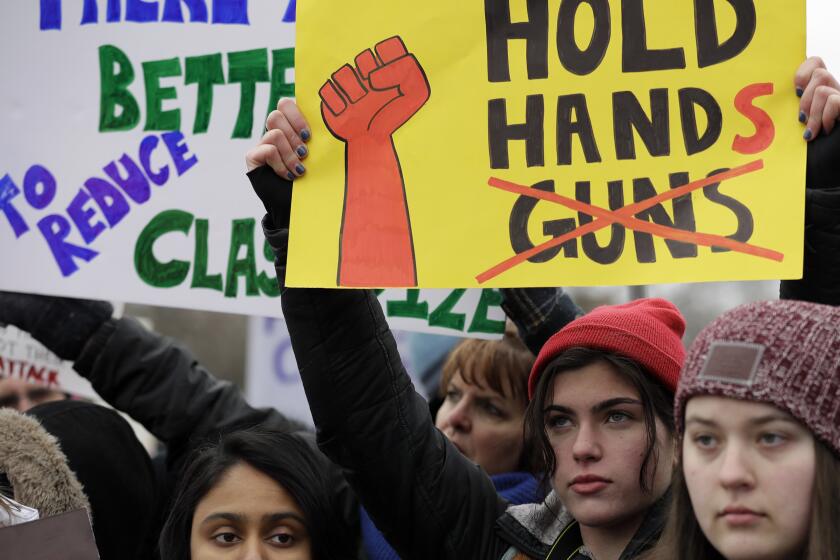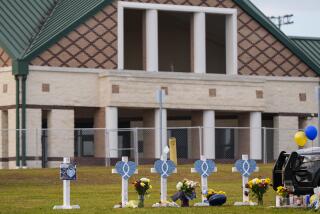Op-Ed: The powerful message behind charging the parents in the Michigan school shooting
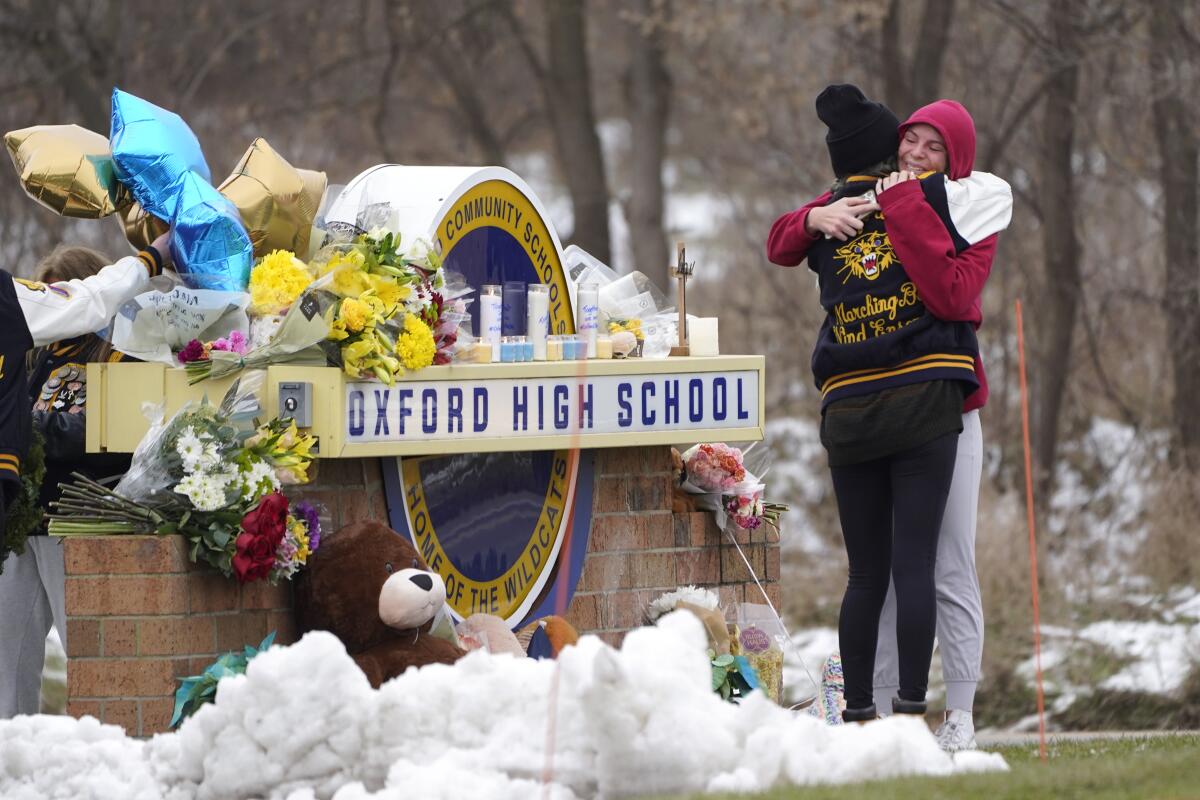
- Share via
The latest school shooting tragedy, in Michigan on Nov. 30, shares many common traits with those that came before it. The suspect was a young male student at the school in the midst of a noticeable crisis. He had communicated intent to do harm. He got a firearm from a family member who had failed to store it securely.
But one crucial thing is different — the suspect’s parents have been criminally charged for their role in the crime. This decision is a powerful reminder that no child kills in a vacuum, and it might be key to unlocking legislative action that could help prevent school shootings.
The 15-year-old boy’s father purchased a semiautomatic pistol four days before the shooting as a gift for his son. Over the weekend, the boy and his mother both posted about the gun on social media. After the boy was caught at school Monday searching for ammunition on his phone, his mother texted, “LOL I’m not mad at you. You have to learn not to get caught.”
Experts say guns used in U.S. school shootings have often come from the homes of young perpetrators.
The Tuesday morning of the shooting, the suspect drew a picture of a gun pointing at the words “the thoughts won’t stop. help me.” He also drew a bullet with the phrases “blood everywhere,” “my life is useless” and “the world is dead.” When his parents were summoned to the school and told to send their son to counseling, they allegedly resisted the idea of immediately taking him out of school and left without him — and the gun in his backpack. The gun had been kept in an unlocked drawer in their bedroom.
Their son is now accused of killing four students and injuring seven other people at Oxford High School, about 45 miles north of Detroit. His parents have been charged with four counts of involuntary manslaughter, which means there was no premeditation or intent to kill, only that they acted in a reckless manner. The couple pleaded not guilty and face up to 60 years in prison if convicted.
It’s rare for adult gun owners to be charged in relation to school shootings because parents of shooters have a constitutional right to own a firearm and most states don’t have laws requiring gun owners to secure their weapons when children are in the household. In some mass school shootings, there have been no parents to prosecute because their children had also killed them with guns the parents owned.
The Michigan attack was the first mass shooting at a school since 2018, when 17 people were killed in Parkland, Fla., and 10 were fatally shot in Santa Fe, Texas. In our database of mass public shootings in the U.S., it is the 12th school shooting with four or more fatalities since 1966.
School shooters are nearly always too young to legally own a weapon or take it outside the home. Of all the common-sense gun laws typically proposed after school shootings — universal background checks, extreme-risk protection orders, an assault weapons ban — safe storage is the most directly applicable. In our research, around 60% of the 37 guns brought to the scene of the 12 school mass shootings came directly from family members. Only four of the 14 shooters didn’t get a gun from home.
The parents of the teen charged in Michigan school shooting plead not guilty to involuntary manslaughter charges and have bond set at $500,000 each.
Proposals requiring secure storage at home are generally popular among gun owners and non-gun owners alike. Research shows they can help prevent gun thefts, suicides and accidental shootings, in addition to school shootings. One study found that keeping firearms locked up can reduce shootings in the home by 75%.
Thirty-one states have child access prevention laws, but only 11 states have any sort of safe storage legislation. Michigan isn’t one of them. In California, parents can be criminally charged if they keep an unlocked firearm on their property where children can get hold of it, but it is nearly impossible to enforce without going door-to-door with a search warrant.
The Oxford school shooting case could be a catalyst for federal legislation to sew up this patchwork quilt of policies. A majority of gun owners admit they do not safely store all of their firearms. According to a 2015 national study, about 1 in 5 gun-owning households with children under 18 stores at least one weapon in the least safe manner — loaded and unlocked.
And that was before record gun sales and the rise of homemade “ghost guns,” like the one used last week by a 13-year-old who allegedly trafficked in ghost guns and accidentally shot and killed his sister. A 16-year-old also used such a gun in 2019 to kill two students at Saugus High School in Santa Clarita.
An estimated 4.6 million American children live within reach of a loaded gun. But the charges in the Oxford shooting case are about more than firearm safety. They are about shining a light on the systemic failure to take the warning signs of violence seriously.
If we respond to school shooting threats with criminal charges, it encourages silence when we need people to open up so shootings can be prevented.
Time and again, our research shows, adults have denied that an eventual school shooter is capable of serious violence or have failed to act on warning signs — and a child’s explicit cries for help. Shootings and threats of shootings in schools are only rising. Our children are under fire.
One painful lesson from the Michigan attack: Cameras, security guards and active-shooter drills don’t prevent school shootings. We need a nationally funded mandate that would create multi-agency threat assessment and crisis response teams in every school and community so that children in crisis feel seen and heard, and can be immediately connected to the help and support they need.
We also need to make sure those children can’t grab a gun left lying around — or worse, use one that an adult handed to them.
James Densley is a professor of criminal justice at Metropolitan State University. Jillian Peterson is a professor of criminology and criminal justice at Hamline University. They are co-founders of the Violence Project research center and coauthors of “The Violence Project: How to Stop a Mass Shooting Epidemic.”
More to Read
A cure for the common opinion
Get thought-provoking perspectives with our weekly newsletter.
You may occasionally receive promotional content from the Los Angeles Times.
